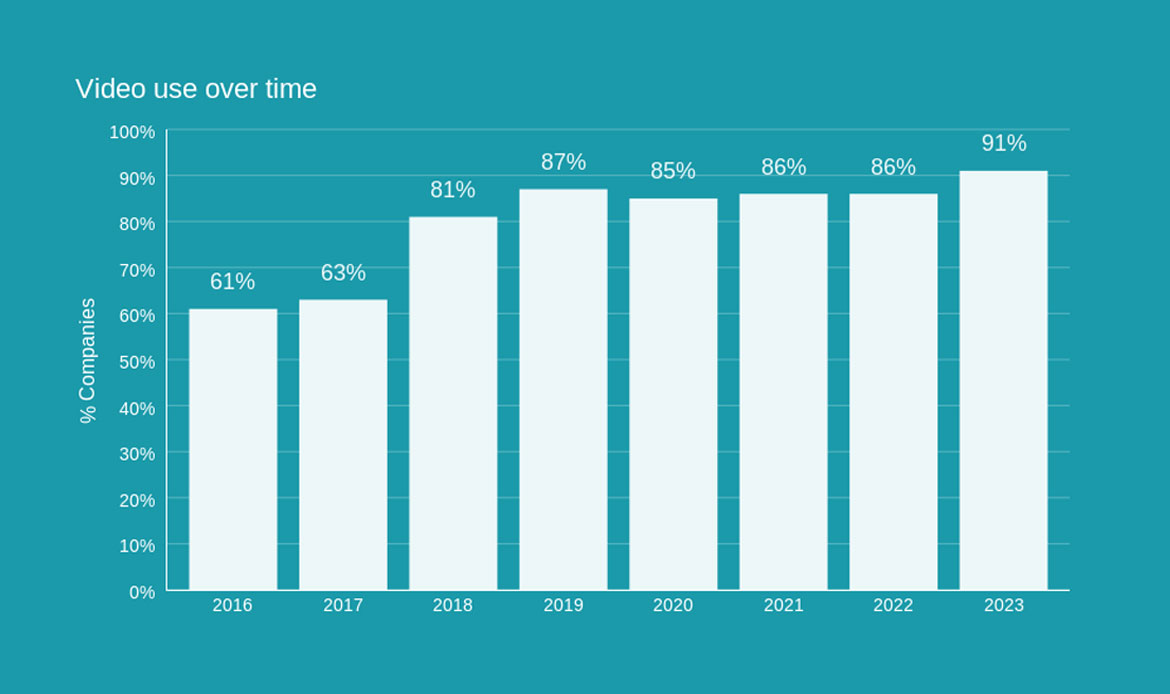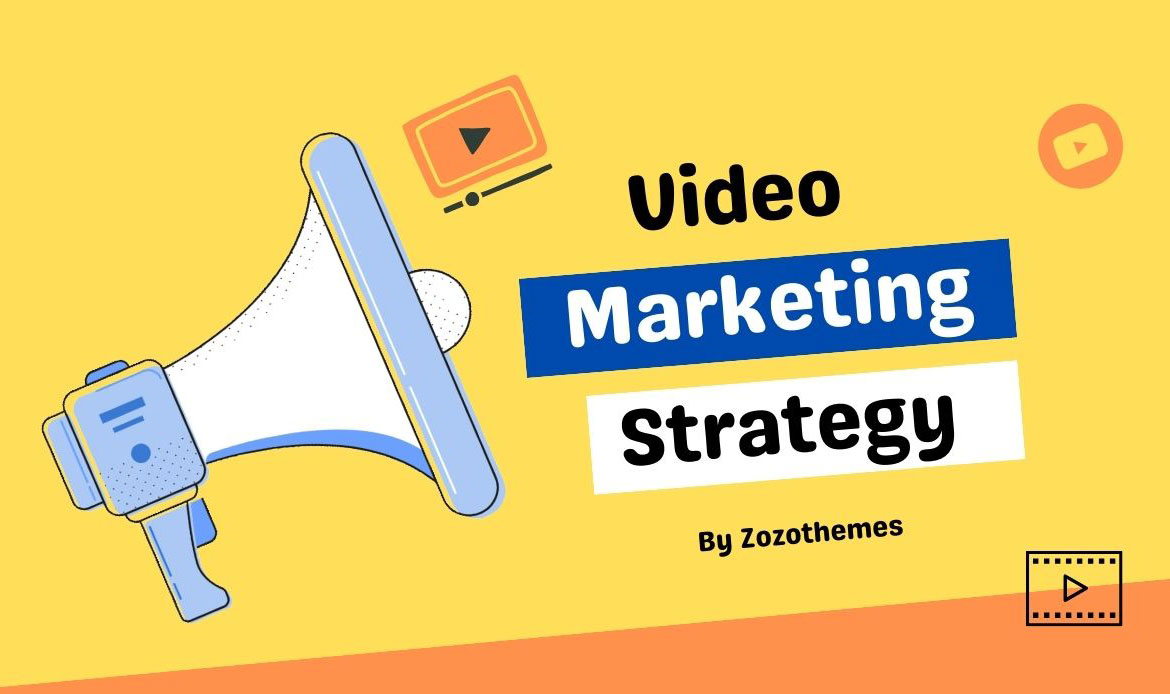Welcome to the future of marketing! As we stand on the precipice of 2024, the landscape of digital engagement is undergoing a seismic shift, and at the forefront of this transformation is Video Marketing.
This Ultimate Guide is your passport to navigating the dynamic and ever-evolving realm of video content in the coming year. In an era where attention spans are fleeting and the demand for immersive experiences is at an all-time high, mastering the art of Video Marketing is non-negotiable.
Join us on a journey through the latest trends, cutting-edge strategies, and emerging technologies that will define the video marketing landscape in 2024.
Whether you’re a seasoned marketer or a budding entrepreneur, this guide is designed to equip you with the knowledge and insights needed to not only keep pace but to lead the charge in the competitive digital arena. From the rise of new platforms to the evolution of storytelling techniques, we’ll delve into every aspect that will shape the way brands connect with their audiences through the power of video.
Get ready to unlock the secrets to creating compelling, shareable, and memorable video content. Video Marketing in 2024 is not just a trend; it’s a strategic imperative. Let’s embark on this exciting journey together and redefine the way you engage with your audience in the year ahead. The future of marketing is visual, and the time to harness its potential is now.
What Is Video Marketing?

Video marketing is a digital marketing strategy that involves the creation and distribution of video content to promote a brand, product, or service. It leverages the power of visual and auditory elements to engage and connect with the target audience, conveying messages in a compelling and memorable way. Video marketing utilizes various platforms, including social media, websites, email campaigns, and video-sharing platforms, to reach a wider audience and deliver content that resonates with viewers.
Key elements of video marketing include storytelling, visuals, and sound, which collectively contribute to creating a more immersive and impactful experience for the audience. Videos can take various forms, such as promotional videos, tutorials, testimonials, product demonstrations, and behind-the-scenes footage, depending on the marketing goals and target audience.
Video marketing offers several advantages, including increased engagement, higher retention rates, and the ability to convey complex information more efficiently than text alone. Additionally, it has become an essential component of modern marketing strategies, as consumers increasingly prefer video content over other forms of communication.
Whether used for brand awareness, product launches, educational purposes, or customer engagement, video marketing has proven to be a versatile and effective tool for businesses and marketers looking to connect with their audience in a more dynamic and visually appealing way.
Why Is Video Marketing Important?

Increased Engagement: Videos are highly engaging and capture attention more effectively than text or static images. People are more likely to watch a video than read a lengthy article, making it a powerful tool to connect with your audience.
Improved Information Retention: Visual and auditory elements in videos enhance information retention. Viewers are more likely to remember content conveyed through video, making it an effective medium for delivering messages and information.
Enhanced Conveyance of Emotion and Personality: Videos allow for the expression of emotions and the conveyance of the brand’s personality. This emotional connection can foster a stronger bond between the brand and its audience.
Versatility in Content: Video marketing offers a wide range of content options, from product demonstrations and tutorials to storytelling and behind-the-scenes glimpses. This versatility makes it suitable for various marketing goals and audience preferences.
Increased Social Media Visibility: Social media algorithms often favor video content, leading to higher visibility and engagement on platforms like Facebook, Instagram, and Twitter. Video content is more likely to be shared, extending its reach even further.
Improved SEO Performance: Search engines value video content, and websites with engaging videos often rank higher in search results. Including videos on your website can contribute to better search engine optimization (SEO) and increased online visibility.
Better Conversion Rates: Video content has been shown to increase conversion rates. Whether it’s encouraging viewers to make a purchase, sign up for a newsletter, or take another desired action, well-crafted videos can drive conversions more effectively than other forms of content.
Adaptation to Consumer Preferences: As consumers increasingly prefer visual content, businesses need to adapt to these preferences. Video marketing allows brands to meet their audience where they are and deliver content in a format that resonates with them.
Global Reach: With the internet’s global reach, videos can be easily shared and accessed by a worldwide audience. This makes video marketing an effective way for businesses to expand their reach and connect with diverse audiences.
Measurable Analytics: Video marketing platforms provide detailed analytics, allowing businesses to track the performance of their videos. This data helps marketers understand viewer behavior, preferences, and the overall impact of their video marketing efforts, enabling them to refine their strategies.
Types of Marketing Videos

There are various types of marketing videos, each serving a specific purpose in engaging and connecting with the audience. Here are some common types of marketing videos:
Promotional Videos:
Purpose: Build awareness and generate interest in a product, service, or brand.
Content: Highlights key features, benefits, and value propositions.
Explainer Videos:
Purpose: Clarify complex concepts or demonstrate how a product or service works.
Content: Uses animation, graphics, and narration to simplify and explain.
Product Demonstrations:
Purpose: Showcase the functionality and benefits of a product.
Content: Demonstrates the product in use, highlighting key features.
Testimonials and Case Studies:
Purpose: Build trust and credibility by showcasing positive experiences of satisfied customers.
Content: Features real customers sharing their success stories and experiences.
Behind-the-Scenes Videos:
Purpose: Humanize the brand and give viewers a glimpse of the company culture.
Content: Takes viewers behind the scenes of the business, showing day-to-day operations and the people behind the brand.
How-to and Tutorial Videos:
Purpose: Educate and provide value to the audience by explaining processes or teaching new skills.
Content: Step-by-step instructions or demonstrations of how to use a product or accomplish a task.
Live Videos:
Purpose: Foster real-time engagement and interaction with the audience.
Content: Conduct live events, Q&A sessions, product launches, or behind-the-scenes footage.
Interactive Videos:
Purpose: Encourage viewer participation and engagement.
Content: Allows viewers to make choices, answer questions, or interact with the content in real-time.
Brand Storytelling Videos:
Purpose: Establish an emotional connection with the audience by narrating the brand’s history, values, and mission.
Content: Uses storytelling elements to convey the brand’s narrative and personality.
Event Recap Videos:
Purpose: Summarize and highlight key moments from events, conferences, or product launches.
Content: Showcases event highlights, interviews, and attendee reactions.
User-Generated Content (UGC) Videos:
Purpose: Leverage content created by customers to build trust and authenticity.
Content: Features real customers sharing their experiences with the product or brand.
Interactive Product Tours:
Purpose: Engage potential customers by providing an interactive tour of a product.
Content: Allows viewers to explore different features and aspects of the product at their own pace.
Comedic or Entertainment Videos:
Purpose: Create brand awareness and entertain the audience.
Content: Uses humor or entertainment value to engage viewers while subtly incorporating the brand or product.
Educational Series:
Purpose: Establish thought leadership and educate the audience on industry-related topics.
Content: Consists of a series of videos covering different aspects of a specific subject.
Choosing the right type of video depends on the marketing goals, target audience, and the message a brand wants to convey. A strategic combination of these video types can form a comprehensive and engaging video marketing strategy.
The Current State of Video Marketing:
Before diving into the future, it’s essential to understand the current state of Video Marketing. Video content has transcended its role as a supplementary marketing tool, becoming the primary means of communication for brands across industries. From social media platforms to company websites, video has become the preferred medium for conveying messages due to its ability to evoke emotions, tell compelling stories, and leave a lasting impact on viewers.
- Video is a key component in the marketing strategies of 85% of businesses.
- A significant 92% of marketers acknowledge the importance of video in their overall marketing strategies.
- Nearly half of marketers, accounting for 46%, assert that video marketing has become notably more cost-effective.
- This year, 70% of brands are increasing their video production compared to previous periods.
- The effectiveness of video in capturing online attention is affirmed by 85% of marketers.
- Additionally, an impressive 91% of marketers express satisfaction with the return on investment (ROI) derived from their social media video marketing efforts.
The Evolution of Video Marketing:

Video Marketing has come a long way since the early days of online content. From being an optional supplement to a website, videos have become a central player in online marketing strategies. In 2024, this evolution reaches new heights, driven by advancements in technology, changes in consumer behavior, and the need for more immersive, engaging content.
Anticipated Trends in 2024:
Interactive Experiences:
The passive viewing experience is evolving into interactive engagement. In 2024, we anticipate a surge in interactive videos, allowing viewers to actively participate and shape their journey through the content. This could include clickable elements, polls, and immersive storytelling experiences.
Short-Form Dominance:
Short-form video content, pioneered by platforms like TikTok and Instagram Reels, will continue to dominate. Brands must master the art of concise, attention-grabbing storytelling to connect with audiences in the ever-diminishing window of user attention.
Augmented Reality Integration:
The intersection of video and augmented reality is creating groundbreaking experiences. Expect brands to leverage AR technology for virtual try-ons, product demonstrations, and immersive storytelling, blurring the lines between the digital and physical worlds.
Livestreaming Evolution:
Livestreaming is not just a trend; it’s a cornerstone of real-time engagement. In 2024, expect further evolution with enhanced production quality, interactive features, and innovative uses, making it an indispensable tool for brand-consumer interactions.
AI-Personalized Videos:
Artificial Intelligence will play a significant role in tailoring video content to individual viewers. Dynamic content, personalized recommendations, and user-specific experiences will become the norm, enhancing the relevance and impact of video marketing efforts.
Video Marketing Strategies for Success in 2024:

As we approach 2024, the realm of video marketing continues to evolve, presenting new challenges and opportunities for businesses. To ensure success in the coming year, consider the following video marketing strategies:
Embrace Short-Form Content:
With attention spans decreasing, focus on creating concise and engaging short-form videos. Platforms like TikTok and Instagram Reels will continue to thrive, making it essential to deliver your message effectively in a shorter timeframe.
Prioritize Mobile Optimization:
Given the dominance of mobile video consumption, optimize your videos for mobile viewing. Ensure that your content is visually appealing and functions seamlessly on various mobile devices.
Interactive and Shoppable Videos:
Explore interactive video formats that encourage viewer participation. Additionally, incorporate shoppable elements into your videos to facilitate direct purchasing from the content, streamlining the customer journey.
Invest in Live Video:
Leverage the authenticity of live video to connect with your audience in real-time. Host live events, Q&A sessions, product launches, and behind-the-scenes content to foster engagement and build a sense of community.
Enhance Personalization with AI:
Utilize artificial intelligence (AI) to personalize your video content based on viewer data. Tailor recommendations, content suggestions, and even the video narrative to enhance the viewer’s experience and increase engagement.
Diversify Content on Multiple Platforms:
Adopt a multi-platform approach by creating content tailored to the strengths and characteristics of different platforms. Whether on YouTube, Instagram, TikTok, or emerging platforms, diversify your content to maximize reach.
Storytelling with Impact:
Craft compelling narratives that resonate with your audience emotionally. Focus on telling authentic stories that connect your brand with the values and aspirations of your target demographic.
Explore Virtual and Augmented Reality:
Consider integrating virtual and augmented reality elements into your videos for a more immersive experience. Whether it’s virtual product demonstrations or augmented reality filters, stay on the cutting edge of technology.
Strategic Use of User-Generated Content (UGC):
Encourage your audience to create and share content related to your brand. Incorporate UGC into your video marketing strategy to build trust, authenticity, and a sense of community around your brand.
Optimize for Search Engines:
Implement SEO best practices for your video content. Use descriptive titles, tags, and video descriptions to enhance discoverability and increase the chances of your videos appearing in search engine results.
Educational Content for Thought Leadership:
Position your brand as a thought leader by creating educational content. Share insights, industry trends, and valuable information to establish authority in your niche.
Measure and Analyze Performance:
Utilize analytics tools to measure the performance of your videos. Track metrics such as view counts, watch time, engagement, and conversion rates. Use these insights to refine and optimize your video marketing strategy.
By incorporating these video marketing strategies into your approach for 2024, you can stay ahead of the curve, engage your audience effectively, and achieve success in a competitive digital landscape.
Essential Video Marketing Tools for 2024:

As video marketing continues to evolve, staying ahead of the curve requires leveraging a suite of tools to enhance production, analytics, and overall strategy. Here are essential video marketing tools to consider for 2024:
Video Editing Software:
Recommended Tool: Adobe Premiere Pro, Final Cut Pro, or DaVinci Resolve
Why: Professional video editing software allows for precise editing, transitions, and enhancement of visual elements in your videos.
Animation and Motion Graphics:
Recommended Tool: After Effects, Blender, or Vyond
Why: Create engaging animations and motion graphics to make your videos visually appealing and dynamic.
Live Streaming Platforms:
Recommended Tool: OBS Studio, Streamlabs, or Be.Live
Why: For real-time engagement and live events, use live streaming platforms to connect with your audience and build a sense of immediacy.
Interactive Video Creation:
Recommended Tool: Rapt Media, HapYak, or Wirewax
Why: Enhance viewer engagement with interactive videos, allowing users to make choices or click on elements within the video.
Virtual Reality (VR) Production:
Recommended Tool: Unity 3D or InstaVR
Why: If applicable to your industry, explore VR tools to create immersive experiences for your audience.
Augmented Reality (AR) Integration:
Recommended Tool: Spark AR Studio, Lens Studio, or ZapWorks
Why: Incorporate AR elements into your videos for an interactive and enhanced viewing experience.
Video Hosting and Distribution:
Recommended Tool: YouTube, Vimeo, or Wistia
Why: Host and distribute your videos on platforms that provide analytics, accessibility, and ease of sharing.
AI-Powered Video Analytics:
Recommended Tool: Vidyard, Wyzowl, or Brightcove
Why: Utilize AI-driven analytics to gain insights into viewer behavior, preferences, and engagement metrics.
Personalization and Data Integration:
Recommended Tool: Idomoo, SundaySky, or Adobe Target
Why: Personalize your video content based on viewer data, creating a more tailored and engaging experience.
User-Generated Content (UGC) Platforms:
Recommended Tool: TINT, Yotpo, or Olapic
Why: Aggregate and showcase UGC in your video marketing strategy to build trust and authenticity.
SEO and Video Optimization:
Recommended Tool: TubeBuddy, Morningfame, or SEMrush
Why: Optimize your video content for search engines, improving discoverability and visibility.
Virtual Background and Green Screen Tools:
Recommended Tool: Zoom, Chromavid, or Green Screen by Do Ink
Why: Enhance video production quality by using virtual backgrounds or green screens for a polished look.
Collaboration and Project Management:
Recommended Tool: Slack, Trello, or Asana
Why: Streamline collaboration among team members, track progress, and manage video projects efficiently.
Video Testimonials and Reviews:
Recommended Tool: Boast, Testimonial Hero, or Influitive
Why: Collect and showcase customer testimonials and reviews in video format to build trust.
AI-Powered Voiceovers and Transcriptions:
Recommended Tool: Descript, Otter.ai, or Trint
Why: Use AI tools for automated voiceovers, transcriptions, and captions to enhance accessibility.
By incorporating these video marketing tools into your strategy for 2024, you can streamline your workflow, enhance the quality of your videos, and gain valuable insights to optimize your overall video marketing efforts.
Conclusion
As we conclude our exploration into the vast landscape of Video Marketing in 2024, it’s evident that the power of visual storytelling is not just a trend but a cornerstone of effective digital communication. The insights, strategies, and trends uncovered in this Ultimate Guide underscore the critical importance of integrating video into your marketing arsenal.
In the coming year, the dynamism of video content will continue to redefine the way brands connect with their audiences. The emergence of new platforms, advancements in technology, and the evolving preferences of consumers all contribute to the ever-changing tapestry of video marketing. As a marketer, staying agile and informed will be key to navigating this landscape successfully.
Remember, it’s not just about producing videos; it’s about crafting narratives that resonate, inspire, and engage. The immersive experiences offered by video content have the unparalleled ability to leave a lasting impact on your audience.
Whether you’re a business looking to boost your online presence, an influencer building a personal brand, or a marketer seeking to remain at the forefront of industry trends, Video Marketing in 2024 presents boundless opportunities. Embrace the challenges, experiment with new ideas, and always be willing to adapt.
As we bid farewell to this guide, envision your brand’s journey into the future—a future where compelling visual stories captivate, convert, and inspire action. Video Marketing isn’t just a tool; it’s a strategic imperative that will define the success stories of tomorrow. Embrace the power of video, and let your brand’s narrative unfold in the hearts and minds of your audience. The stage is set, the cameras are rolling—make your mark in the world of Video Marketing in 2024.


